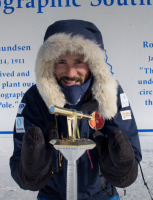Marine Biodiversity
Climate Change
Mangroves, Coral Reefs & Coastal Ecosystems
Ecosystem Services
Carbon Cycle
Climate Adaptation & Resilience
Post-Doctoral Fellowships
United Kingdom
2019.08.11
Climate change mitigation: scaling up mangrove protection in the Philippines
Much like coral reefs, mangroves are extremely rich and productive ecosystems that contribute countless services enhancing human well-being. Besides being home to all sorts of marine life and supporting fisheries, these forests of salt-tolerant trees and shrubs play a forefront role in carbon storage and offer increasingly needed protection against storm surges, two crucial characteristics when it comes to climate change. Alarmingly, mangrove forests are among the most threatened tropical ecosystems in the world. Owing to anthropogenic activities like harvesting and clearing for alternative land-uses, current figures suggest around 35% of them have already been lost. Despite the opportunity they represent for climate change mitigation and adaptation (CCMA), only 39% of mangroves worldwide come under any form of Protected Area coverage (with substantially lower numbers in some regions (e.g. ~3% of mangrove in the Philippines), and this in spite of global efforts to increase marine protection coverage. Recognizing the missed opportunity here, Dr. Clare Duncan, ecologist and conservation biologist at the University of Exeter, aims to help identify mangrove areas where conservation intervention is the most needed and promising. Specifically, she aims to develop spatial tools to determine optimal Marine Protected Area (MPA) designation locations based on several aspects: potential for storm damage impact reduction, carbon storage increase capacity, sustainable development opportunities for local communities, as well as potential for industry support. The objective is to I nform researchers, coastal resource managers and other policy makers about where to concentrate MPA designation efforts to maximize ecosystem services, and associated multi-stakeholder economic returns, in the face of climate change.
In the Philippines, an estimated 50% of mangroves have disappeared. “In the 1980s, in an effort to alleviate poverty, there was a push towards aquaculture development in coastal areas, which led to large-scale deforestation and degradation », reports Clare Duncan. Today, mangrove forests are still present, but they are not very dense and are highly fragmented. A lot of the areas that were transformed into aquaculture ponds are not even used anymore, but abandoned and unproductive”. In other words, the service potential of these ecosystems, whether natural or human-related, is not exploited to the fullest, to say the least. “There’s an opportunity here. Through enrichment planting and rehabilitation of the aquaculture ponds, for instance, we could considerably enhance the benefits we get from these ecosystems”. But given the breadth of the coastal territory covered in mangrove forests, a crucial preliminary question is: where should the rehabilitation efforts be concentrated? Which areas offer the best chances at success and positive impact? “What I’m trying to do with this project, is give people an idea of where and how to act to maximize results”, explains the ecologist. To provide this information, her project offers to combine data across several variables, including carbon sequestration, coastal protection, potential for local communities to engage in protection activities. “A combination of factors comes into play. For instance, some areas already benefit from the protection of other breakwater structures like coral reefs, while others are badly exposed to storm surges.
Innovatively, her approach will also take particular interest in the potential for industry support via Payment for Ecosystem Services (incentives offered to companies in exchange for environmental action). Indeed, “in terms of economic value, there’s a lot of industries that could benefit from engaging in mangrove protection”. Corporate social responsibility, alone, is a good reason. “Companies looking to reduce their carbon footprints have every reason to engage in mangrove rehabilitation activities », she points out. And there are also a lot of other industry-specific incentives. “Take the insurance industry, for instance: increased vulnerability to natural disaster will ultimately impact premiums, especially considering the projected rates of sea level rise”. The reason why there isn’t more uptake from companies yet is unclear, the researcher says, so initiating dialogue is highly promising.
Combining maps to obtain optimal conservation areas
In fact, her methodology involves engaging with actors and stakeholders from many different sectors. The workplan includes the collection and assimilation of information from various sources, including remotely sensed data (satellite), field-derived data (samples), and survey data. The latter will imply collaborating with industry actors, but also with local communities to assess where they are the most likely to engage in mangrove protection, and where extractive activities might be possible to reverse or reduce, and enhance ecosystem services delivery. The satellite data, for its part, will serve to map mangrove distribution and density, localization of fishponds, as well as the proximity of human settlements, and seagrasses and coral reefs. Various maps will be developed as the different sets of data are collected, that will then be integrated into comprehensive spatial planning tools. The methodology used will be deliberately adaptable, Dr. Clare Duncan specifies, in order to be applicable to other regions of the world. Indeed, the aim is not only to facilitate coastal marine protection areas in the Philippines, but to develop novel tools that will get the attention of coastal resource management communities on a global scale, paving the way for similar initiatives elsewhere.
The present project fits into the frame of the current global concern with ‘blue carbon’, a term coined to bring attention to the importance of marine ecosystems in the carbon cycle. Research initiatives such as this one will be crucial for the implementation of successful climate change mitigation strategies in the immediate future. The project is all the more promising as it seeks to keep in touch with the realities of the field, aiming to build upon existing needs and constraints, rather than to ignore them. Along the same line, its concern with industry support gives it every advantage for consideration, financing and uptake by both policy makers and industry stakeholders.

Clare
DUNCAN
Institution
University of Exeter
Country
United Kingdom
Nationality
British
Related articles
Climate Change
Finance, Investment & Risk Management
Societal Challenges
Climate Adaptation & Resilience
Insurance & Risk Management
Environmental Justice
Civil Society & Governance
AXA Project
Italy
AXA Research Lab on Climate Change, Risk and Justice
In response to three research questions: How can the private and financial sectors contribute to a just transition to a... Read more

Gianfranco
PELLEGRINO


